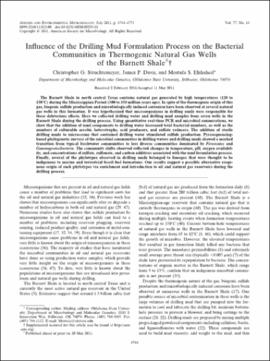| dc.contributor.author | Struchtemeyer, Christopher G. | |
| dc.contributor.author | Davis, James P. | |
| dc.contributor.author | Elshahed, Mostafa S. | |
| dc.date.accessioned | 2018-08-29T14:24:32Z | |
| dc.date.available | 2018-08-29T14:24:32Z | |
| dc.date.issued | 2011-07 | |
| dc.identifier | oksd_struchtemeyer_influenceofthed_2011 | |
| dc.identifier.citation | Struchtemeyer, C. G., Davis, J. P., & Elshahed, M. S. (2011). Influence of the drilling mud formulation process on the bacterial communities in thermogenic natural gas wells of the Barnett Shale. Applied and Environmental Microbiology, 77(14), 4744-4753. https://doi.org/10.1128/AEM.00233-11 | |
| dc.identifier.uri | https://hdl.handle.net/11244/301609 | |
| dc.description.abstract | The Barnett Shale in north central Texas contains natural gas generated by high temperatures (120 to 150°C) during the Mississippian Period (300 to 350 million years ago). In spite of the thermogenic origin of this gas, biogenic sulfide production and microbiologically induced corrosion have been observed at several natural gas wells in this formation. It was hypothesized that microorganisms in drilling muds were responsible for these deleterious effects. Here we collected drilling water and drilling mud samples from seven wells in the Barnett Shale during the drilling process. Using quantitative real-time PCR and microbial enumerations, we show that the addition of mud components to drilling water increased total bacterial numbers, as well as the numbers of culturable aerobic heterotrophs, acid producers, and sulfate reducers. The addition of sterile drilling muds to microcosms that contained drilling water stimulated sulfide production. Pyrosequencing-based phylogenetic surveys of the microbial communities in drilling waters and drilling muds showed a marked transition from typical freshwater communities to less diverse communities dominated by Firmicutes and Gammaproteobacteria. The community shifts observed reflected changes in temperature, pH, oxygen availability, and concentrations of sulfate, sulfonate, and carbon additives associated with the mud formulation process. Finally, several of the phylotypes observed in drilling muds belonged to lineages that were thought to be indigenous to marine and terrestrial fossil fuel formations. Our results suggest a possible alternative exogenous origin of such phylotypes via enrichment and introduction to oil and natural gas reservoirs during the drilling process. | |
| dc.format | application/pdf | |
| dc.language | en_US | |
| dc.publisher | American Society for Microbiology | |
| dc.rights | This material has been previously published. In the Oklahoma State University Library's institutional repository this version is made available through the open access principles and the terms of agreement/consent between the author(s) and the publisher. The permission policy on the use, reproduction or distribution of the material falls under fair use for educational, scholarship, and research purposes. Contact Digital Resources and Discovery Services at lib-dls@okstate.edu or 405-744-9161 for further information. | |
| dc.title | Influence of the drilling mud formulation process on the bacterial communities in thermogenic natural gas wells of the Barnett Shale | |
| osu.filename | oksd_struchtemeyer_influenceofthed_2011.pdf | |
| dc.description.peerreview | Peer reviewed | |
| dc.identifier.doi | 10.1128/AEM.00233-11 | |
| dc.description.department | Microbiology and Molecular Genetics | |
| dc.type.genre | Article | |
| dc.type.material | Text | |
| dc.subject.keywords | aquatic organisms | |
| dc.subject.keywords | bacteria | |
| dc.subject.keywords | betaproteobacteria | |
| dc.subject.keywords | gammaproteobacteria | |
| dc.subject.keywords | microbial consortia | |
| dc.subject.keywords | natural gas | |
| dc.subject.keywords | phylogeny | |
| dc.subject.keywords | soil microbiology | |
| dc.subject.keywords | sulfides | |
| dc.subject.keywords | texas | |
